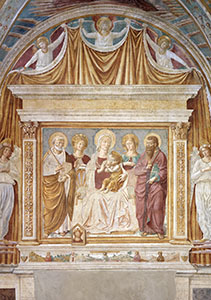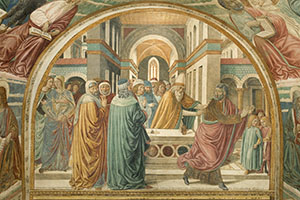
The Virgin and Child Enthroned Surrounded by Saints Peter, Catherine of Alexandria, Margaret and Paul, Tabernacle of the Madonna of the Cough, Benozzo Gozzoli Museum, Castelfiorentino.

The Expulsion of Joachim, Tabernacle of the Visitation, Benozzo Gozzoli Museum, Castelfiorentino.
During his career, Benozzo engaged several times in the decoration of tabernacle/oratory monuments situated on main roads used by travellers and pilgrims. The most significant of these in terms of size and commission were perhaps the two he did for Castelfiorentino, commissioned by the prior of Castelnuovo, Messer Grazia di Francesco, one in 1814, dedicated to the Madonna of the cough, and the other in 1492, in partnership with his sons, Francesco and Alesso, usually known as the Madonna of the Visitation.
In the 1860s, in order to preserve them, these frescoes were removed from their original sites (the Chapel of the Madonna of the cough at the Castelnuovo d’Elsa junction and the Chapel of the Visitation on what is now Via Benozzo Gozzoli) and placed in storage at the Superintendence in Florence for about twenty years. Then, in 1987, they were brought out and exhibited in the Public Library where the limited space prevented the Tabernacles from being displayed at their original height.
At the end of October 2008, the two Tabernacles were taken down and packaged for transport to the new Benozzo Gozzoli Museum on Via Testaferrata, in the heart of Castelfiorentino’s historic centre. In order to transfer them to their new location, an opening was made by the window on the third floor of the Library from which the frescoes were lowered to the ground with the help of a crane.
Particular care was taken with regard to the reassembly of the works. Indeed, the ideal rooms of the new Benozzo Gozzoli Museum (BeGo), designed by the Mariani studio, made it possible to replace the imitation polychrome marble surface of the Tabernacle of the Madonna of the cough, while that of the Visitation is once again displayed in all its glory (approximately 6 metres in height), exhibited to even greater effect by a gallery which allows it to be viewed from both the first and second floors.
During this operation, the frescoes also underwent careful restoration by Fabrizio Iacopini, involving meticulous cleaning, strengthening of the colours and, where necessary and possible, filling in of some gaps in accordance with the scientific and scholarly criteria of modern Italian restoration.
One more fresco attributed by scholars to Benozzo Gozzoli, commissioned by the podesta Jacopo di Antonio Peri in 1490, is housed in the Town Hall. Its subject is Saint Verdiana and it is one of the area’s most ancient testimonies to the worship of this figure who is depicted, in accordance with traditional iconography, as a nun dressed in a dark habit accompanied by her characteristic attributes, namely snakes and a little wicker basket. Verdiana was born in Castelfiorentino and, after various pilgrimages, withdrew to cloistered life. According to popular tradition, she was kept company by some snakes which she fed. In the basket, she kept the skull of a snake as a reminder of her solitude, a clove of garlic (her only food), a statuette of Saint James to remind her of her journey to Compostela, and a small cross made of sulphur crystals to ward off evil spirits.
Serena Nocentini